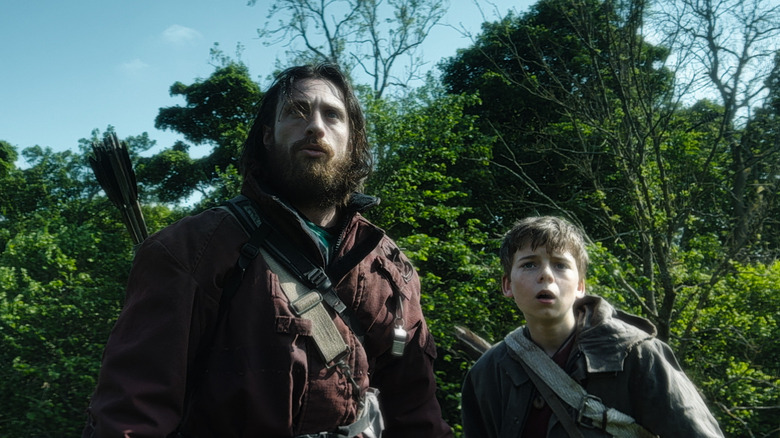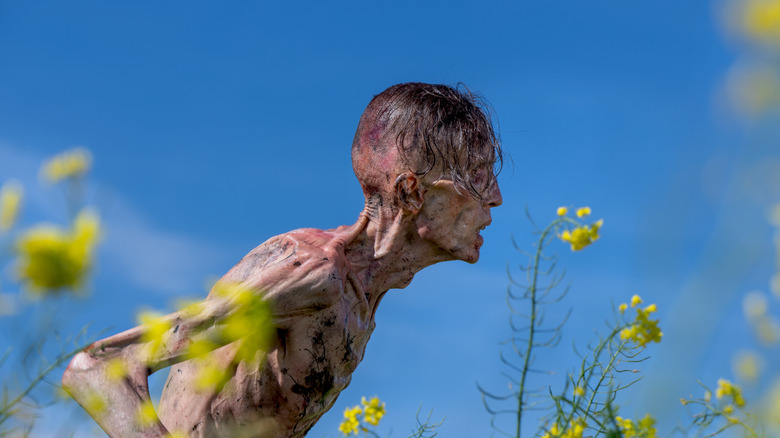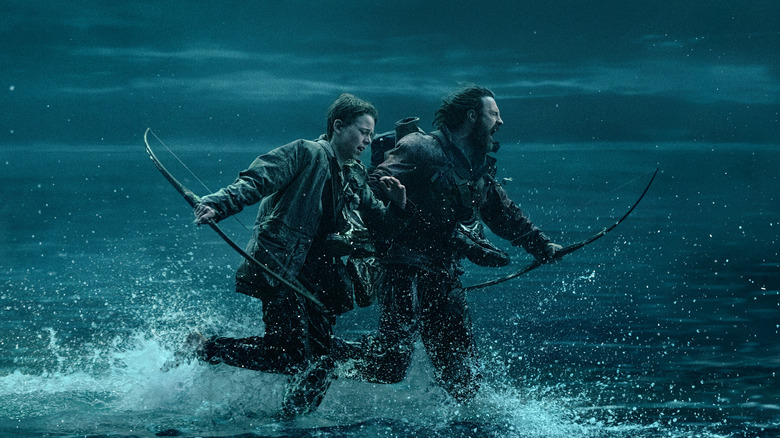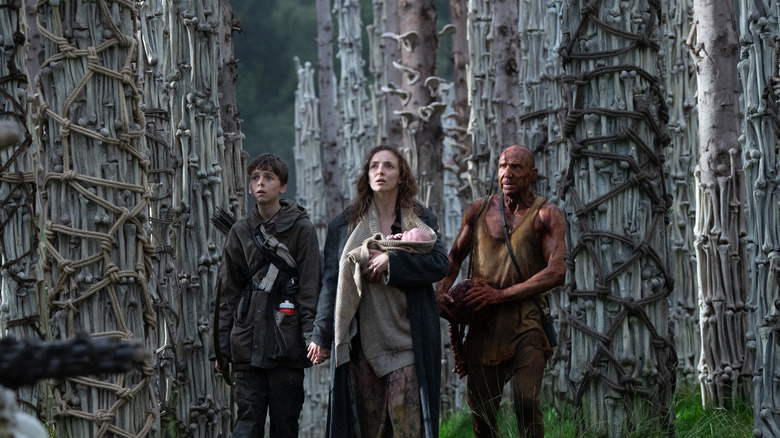28 Years Later Review: A Scary, Gruesome, And Surprisingly Emotional Horror Saga
Danny Boyle's "28 Years Later" comes very close to being one of the best zombie movies ever made (yes, I know the ghouls on display are not technically zombies but rather "infected," but for all intents and purposes, they're zombies). Then the ending arrives. Don't worry: I'm not going to give away spoilers in this review, but it's almost impossible to talk about "28 Years Later" without pointing out that the ending lands with a weird thud.
Because studios can't be content to just make one movie anymore, "28 Years Later" is the first of a whole new trilogy (the second film, titled "28 Years Later: The Bone Temple," is due out in January of 2026). Thanks to this approach, "28 Years Later" simply can't end — it has to set up the next story. And that's unfortunate, because everything leading up to that sequel table-setting moment is remarkable and effective, resulting in a scary, gruesome, and surprisingly emotional experience. Then an utterly baffling, deliriously wacky coda arrives and leaves a bad taste in your mouth.
Are the final minutes of the film enough to sabotage the rest? No, thankfully. But I sure wish they weren't there. I wish Boyle and writer Alex Garland had thought to leave well-enough alone and let us just sit with an otherwise powerful horror saga. I also can't help but wonder how this ending will play with audience members who don't realize this is supposed to the first installment of a trilogy; I could tell that some folks at my screening, clearly not clued into this, were utterly baffled.
28 Years Later improves on the formula of the first film
Still, practically everything leading up to that moment works, and works exceedingly well. "28 Years Later" is the third entry in a story that began all the way back in 2002, where Boyle and Garland teamed up to make "28 Days Later," a post-apocalyptic saga about Great Britain being overrun by bloodthirsty lunatics infected with something dubbed the Rage virus. Those attacked by other infected people find themselves infected almost immediately — their eyes turn red, they spew blood from their mouths, and they immediately start attacking and killing anyone unlucky enough to be in their general vicinity. "28 Days Later" was a down and dirty horror pic, shot on digital by Anthony Dod Mantle, with Cillian Murphy wandering around an eerily abandoned London. "28 Days Later" was followed by the sequel "28 Weeks Later." Boyle didn't return to direct that film, and Garland only contributed to rewrites.
Now, the original team (including Mantle) are back, and they've only improved on the formula. While "28 Years Later" doesn't have the same grainy digital vibe as the original, Boyle and Mantle get creative, employing all sorts of tricks and visual sleight-of-hand to catch the viewer off guard. Boyle and editor Jon Harris will frequently splice in stock footage and footage from other movies in the middle of a scene, and there are moments of violence that invoke the "bullet time" effect used so memorably in "The Matrix," where the image will freeze so the camera can rotate and show us bursts of blood from various angles. It's jarring and unique, and it constantly made me uneasy in the best possible way.
After a brutal prologue that wastes no time unleashing gruesome imagery, "28 Years Later" cuts to the heart of the matter. As the title suggests, 28 years have passed since the virus was unleashed, and the outbreak has been contained by quarantining the UK and cutting it off from the rest of the world (Garland's script later hammers home the point that the outside world has essentially moved on as if hordes of zombies aren't still stalking about somewhere).
28 Years Later is loaded with almost unbearable tension
One island community has learned to live in harmony, cut-off from the mainland. It helps that the island is only accessible via a causeway that disappears when the tide comes in. 12-year-old Spike (newcomer Alfie Williams, who is wonderful here, turning in a confident, realistic performance) lives on the island with his rough-and-tumble father Jamie (Aaron Taylor-Johnson) and his suffering mother Isla (Jodie Comer), who is inflicted with some sort of mysterious illness that frequently leaves her bedridden.
The community has a custom in which young people head to the mainland for a hunting trip. They're not hunting game, though — they're hunting infected. Spike and Jamie head out, bows and arrows in hand, and the trip does not go exactly according to plan. Through this first hour of the film, Boyle expertly builds an almost unbearable tension, punctuated by bursts of bloody violence. The infected have evolved overtime, and they've become feral, nude beasts swarming about, guided by hulking leaders known as Alphas. They also seem to be more intelligent than the previous films let on.
During the hunting expedition, Spike learns about a mysterious, potentially insane doctor (eventually played perfectly by Ralph Fiennes) living in seclusion, and the boy gets it in his head that this medical man can cure whatever is ailing his mother. From here, a second journey begins, with Spike and Isla heading out to find the doctor, risking life and limb in the process. All told, "28 Years Later" is a surprisingly simple affair: there's no grander scheme at play here, other than Spike's hope that he can save his mother.
Baffling ending aside, 28 Years Later is surprisingly emotional
This sets up a disarmingly emotional arc that you don't really see in movies like this. Comer, one of the best actors around right now, isn't given enough to do here, but there is a tenderness between mother and son that takes the film far. Don't be surprised if "28 Years Later" makes you cry. This blend of unflinching gore and real, honest emotion is so unlike anything I'm used to seeing in a zombie movie, and it elevates "28 Years Later" to heights I was not expecting at all. Which is why the final moments are so damn frustrating.
Again: no spoilers, I swear. All I'll say is that the tone of these final moments is completely at odds with everything that came before, to the point where it feels like we've stumbled into a completely different movie. Perhaps that's the point, since the upcoming sequel "28 Years Later: The Bone Temple" is a completely different movie, with a different director ("Candyman" reboot filmmaker Nia DaCosta is helming that one). Intentional or not, this scene is disheartening, to the point where I wish Boyle had stuck it on later as a post-credit scene instead of jamming it into the main film.
The ending is a massive disappointment, but it can't undo everything that came before it. Boyle and his team have conjured up a kind of sensory overload — the blend of violence, mixed-media, and a frequently jarring soundtrack swirl together with feverish effect. "28 Years Later" is both scary and touching, and that's not easy to achieve. It's impressive, effective, and memorable. But someone should have told Boyle to nix that finale.
/Film Rating: 8 out of 10
"28 Years Later" opens in theaters on June 20, 2025.



